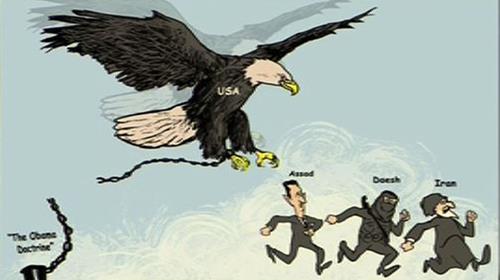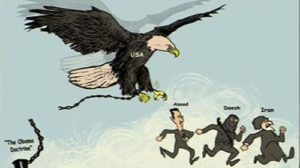

The President orders a military strike that the world’s thugs will notice.
The Wall Street Journal, April 7, 2017 – President Trump inherited the Syrian catastrophe from Barack Obama, and his initial instincts were to accept the awful status quo. But Bashar Assad’s latest chemical attack has galvanized his Administration to think anew, and Mr. Trump’s decision Thursday to launch a retaliatory missile strike is an important first step to save lives, enforce global order, and improve the strategic outlook for the U.S. and its allies.
Mr. Trump starts with the reality that Mr. Obama’s long abdication has left the U.S. with far less leverage than it had when the civil war began in 2011. Iran has become Mr. Assad’s protector on the ground via arms supplies and Hezbollah, and Russia has moved in as a military patron and patroller of the skies. The Muslim opposition the U.S. has been feebly trying to train and arm has been degraded while Mr. Assad and the Russians leave Islamic State to the Kurds and the U.S.-led coalition.
As recently as last week Mr. Trump seemed willing to surrender to this circumstance and do nothing beyond defeating ISIS in Syria’s east.
Mr. Trump also seemed to be courting an accommodation with Russia in Syria, but that road leads to more strategic retreat. Vladimir Putin’s price for restraining Mr. Assad would be steep: U.S. recognition of his conquests in Ukraine and the end of sanctions. This would erode the U.S.-Europe alliance and make Mr. Putin look like a hero back home. Iran might not cooperate in any case, and its goal is an arc of Shiite power from Tehran through Iraq and Syria to the Mediterranean.
The alternative to this surrender is to reassert U.S. influence with diplomacy and military force, and Mr. Assad’s chemical attack is the opening. Mr. Trump may understand this as he ordered an attack on the air base from which the chemical attack was launched, and Mr. Tillerson said Thursday that Mr. Assad has no future in Syria.
The quickest way to punish Mr. Assad for his aerial chemical attacks, and to ensure they won’t happen again, is to destroy his air power. This is the plan that Mr. Obama flinched at in 2013 when he let Mr. Assad cross his “red line.” He has now crossed that line again—this time after having promised to destroy his chemical stockpiles.
On Thursday the U.S. struck only a single airfield, though Mr. Assad has six active airfields used in the war. The U.S. used cruise missiles from outside Syrian air space, which avoided engagement with Russian-manned air defenses. The Pentagon provided the firepower, though we wish Arabs and Europeans could have been included to show the international rejection of Mr. Assad’s war crimes.
Mr. Putin could escalate and engage U.S. forces. But Mr. Obama used that excuse to talk himself into doing nothing, and our guess is that Mr. Putin would shrink from fighting the U.S. lest he risk the humiliation of major losses. As for Russians on the ground, a U.S. source told the press they were forewarned about the attack to avoid casualties.
A stronger attack would have destroyed Syria’s entire air force, and another good step would be for the U.S. and its allies to create the “safe zones” inside Syria that Mr. Trump promised during the campaign. This would be enforced by U.S. and allied air sorties plus renewed military supplies for the opposition. The humanitarian effort would show the U.S. purpose includes protecting the Syrian people. An international force could provide support for havens in multiple locations near the Turkish and Jordanian borders.
***
Every military operation carries risks but this one could also have major political and strategic benefits if Mr. Trump follows the air strike with some forceful diplomacy. The demonstration of renewed U.S. purpose in the region could have an electrifying impact across the Middle East. The Saudis, the Gulf Sunni states and Turkey would begin to rethink their accommodation to the Russia-Assad-Iran axis of dominance that none of them wants.
Mr. Trump also needs to make Russia and Iran begin to pay a price for their support for Mr. Assad’s depredations. They have had no incentive to negotiate an end to the civil war because they see themselves on the road to a relatively cost-free victory. That calculus may change if it looks like the costs of intervening are rising and Mr. Assad is no longer a sure winner.
The Trump Administration has to think about the kind of long-term solution it would like in Syria—perhaps a partition into ethnic enclaves—but the chances of getting there are better if the opposition has safe zones and Mr. Assad can’t maraud with impunity.
The larger point for Mr. Trump to recognize is that he is being tested. The world—friend and foe—is watching to see how he responds to Mr. Assad’s war crime. His quick air strike on the evening he was having dinner with Chinese President Xi Jinping makes clear that the Obama era is over. If he now follows with action to protect Syrian civilians and construct an anti-Assad coalition, he may find that new strategic possibilities open up to enhance U.S. interests and make the Middle East more stable.

